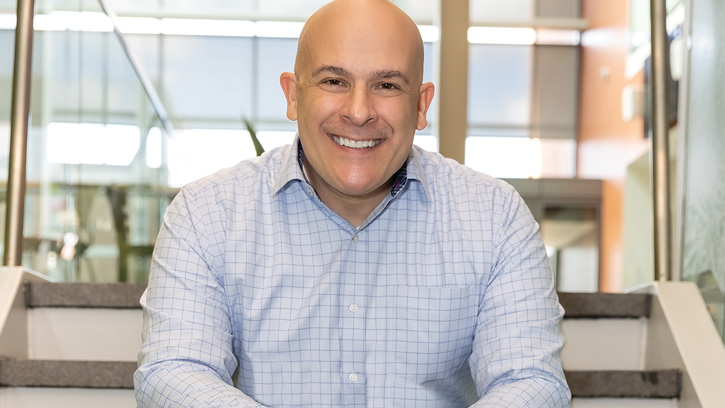Nutrition Gets Up Close and Personal
Nutraceuticals | APPLIED SCIENCE
In 2021, research firm Innova Market Insights identified the concept of “Tailored to Fit,” as one of the year’s top food and beverage industry trends, bringing personalized nutrition and lifestyle-specific personalized nutrition services into the spotlight. Personalized nutrition combines factors like genetics, phenotype, diet/nutrition, microbiome, and metabolome to optimize individual health and behavior.
What does it mean to actually personalize nutrition? Think about nutrition science, technology, and artificial intelligence (AI) intersecting, and you’ll understand the excitement and opportunities in personalized nutrition.
The peer-reviewed Habit PATH (Personalized Approaches to Health) study (deHoogh et al. 2021) is one example of a personalized systems nutrition program, combining both biological and behavioral science. It customized diets according to individual participants’ phenotypic flexibility and ultimately demonstrated that a personalized nutrition program can improve the dietary patterns, lifestyle behaviors, and health-related outcomes of individuals.
Joshua Anthony, CEO of personal nutrition company Nlumn and former chief science officer of Habit LLC, a pioneer in the personal nutrition space, is co-author of the Habit PATH study. In a recent conversation (edited here for clarity and brevity), Anthony shed some light on the evolving personalized nutrition market and the areas where research is taking it.
Q: Is there a consensus definition for personalized nutrition, and if not, how do you define it?
Anthony: I don’t know that there’s any one globally accepted consensus definition. A paper we published in Advances in Nutrition in 2020 has the definition, “Personalized nutrition uses individual specific information, founded in evidence-based science to promote dietary behavior change that may result in measurable health benefits” (Adams et al. 2020).
That definition has some core elements that are essential for any solid definition. First, that aspect of individual, specific information. You must consider the unique needs of the individual. Everyone’s health or well-being goals are going to be different. The second part is around evidence-based. You must understand where a person stands to be able to define where they need to go.
And then finally, the idea about changing behavior. You can have the best biology or measures, but if you can’t ensure that the user is willing and able to make the desired behavior change, you’re not going to see that person achieve their health and well-being goals. So bringing those three things together is essential to any strong and actionable definition of personalized nutrition.
Q: Why is personalized nutrition becoming more important?
Anthony: I think there are probably two big factors. First, increasingly, people are looking to address their health and well-being needs through food. Eighty percent of consumers say that technology has improved their eating experience. Two-thirds of people are restricting one or more components from their diet. There’s something that’s happening at this convergence of food, technology, and health to inform people’s choices.
The second aspect, as it’s impacted all our lives, is the pandemic. Specifically, how it has disproportionately impacted people with chronic lifestyle diseases that are due in part to either poor food access or poor food choices or some combination. And it really underscores the need for people to be able to make better choices in the short term to help improve longer-term health outcomes.
Q: Can you discuss some of the main highlights from the Habit PATH study?
Anthony: The big takeaway is that a systems-based personalized nutrition approach, where we combined biology and behavior, not only enabled people to meet their individual health and well-being needs, but also helped the study population achieve public health goals, like those that are outlined in the Dietary Guidelines.
Critics worry that personalized nutrition programs may move people away from public health targets. We showed the opposite: that by creating diets that cater to individual needs, participant intakes better aligned with current recommendations, like a reduction in saturated fat by 20%. We saw a reduction in sodium and sugar intake by nearly 20%. We saw increases in important, positive nutrients like potassium, fiber, magnesium, vitamin C, beta-carotene. All of these suggested an increased fruit and vegetable intake. This wasn’t a weight loss study, but we did see a decrease in calories, accompanied by weight loss and an improvement in body composition. And people moved more; they were taking more steps.
The final point that I wanted to mention is that we saw some of the best results in the unhealthiest people. One example of that is the unhealthiest group actually reduced their total cholesterol by 10% and their LDL cholesterol by 15%.
Q: What are some of the key takeaways for product developers?
Anthony: The Habit PATH study was a work site wellness study. We divided people into seven subcategories, and we worked with their employers’ foodservice to take those seven diet types and put them into personalized breakfast and lunches for the participants.
The ability to group participants into subcategories allows you to create, in this case, personalized fresh meals for a large number of people. But you could also think about products at scale. It’s an important proof point to show that personalized programs can be used to create things like snacks, soups, or beverages at scale, which is one of the biggest challenges manufacturers often think of.
The Habit PATH study showed that manufacturers can target functional subtypes that can allow them to scale more personalized products in a meaningful way.
Q: Can you share an example of a functional subtype?
Anthony: The functional subtypes detailed in the paper were largely grouped based off differences in macronutrient distribution. For example, different cutoff points and types of carbs, fat, and protein. I will say, too, that we also allowed for some preferences, like vegetarian options, because that’s extremely important.
Q: What kind of work is Nlumn doing with its clients?
Anthony: At Nlumn, we help our clients with everything from personalized nutrition strategy to product commercialization. For example, we partnered with Shaklee to develop their personalized supplement plan, Meology. We worked with McCormick to develop some of the concepts that are behind their EarthRight line of supplements (research-supported herbs and supplements).
We also worked with a healthy aging company, Juvenescence, on their initial R&D to commercialize Metabolic Switch, which is an exogenous ketone ester beverage. The ketone ester beverage very rapidly puts you into a state of nutritional ketosis that lasts for several hours.
And we have several other projects and services in the works. I’m very excited about an app that’s under development that will be coming out [in 2022] but can’t share more on that at this point.
Q: That’s interesting. So you work with technology companies as well?
Anthony: Yeah, it really is. I’ll come back to that earlier point about this intersection between food, technology, and health. It really is about bringing together an ecosystem of providers. And that is core to some of the value that we bring.
It’s about helping a company put the consumer at the center of a personalized ecosystem and understanding where that company fits. Then we help identify other partners that can really bring the consumer product or service to life.
Food and beverage companies wonder how they can play. Food and beverage companies have the single greatest behavior change modification tool there is. They have the end product, and there are so many technology providers that are anxious to work with them and want to know, “How can I apply my science?”
Q: What other opportunities do you see for food and beverage manufacturers?
Anthony: I can briefly speak about two types of consumers seeking personalized nutrition, the subjective personalized consumer and the objective personalized consumer.
There are opportunities to develop products and services for both.
Subjective types reflect the bulk of health and well-being consumers, and probably the bulk of personalized consumers today. They try one or more diet types or diet tribes to meet their personal goals based on information from influencers or friends who’ve had success following a specific eating pattern. However, they don’t have data to suggest the eating pattern they select is right for them.
There’s a smaller subset, say 10% of consumers, that are the objective personalized consumers. They’re the ones that are already actively tracking their lifestyle behaviors and maybe tracking biomarkers and are looking for solutions based on science. They’re not necessarily coming in with a bias.
In either group, you still must be mindful of preferences and you need to be mindful of nutrition gaps to make sure that you can deliver a strong solution to either group.
Q: Where do you see personalized nutrition research focusing right now?
Anthony: There are a lot of areas that I think are really exciting. The first one is the technology that we used in the Habit PATH study. It’s an approach pioneered by the Dutch Research Organization TNO, which measures phenotypic flexibility. Phenotypic flexibility is a sensitive way to quantify your body’s response to an external stress. You provide a nutrient-dense shake to look at how people’s biomarkers change over time in response to the nutritional challenge. The insightful thing here is the best way to tell how somebody should eat is to challenge their body with food and see how they react.
This approach also allows you to detect early changes in markers before you get to a point of disease-enabling early intervention. It has a lot of potential for looking at biomarkers of health, and that’s going to allow personalized nutrition to go more into performance and health optimization.
I think this whole area about unlocking the power of plants is an exciting area. Brightseed is an AI-driven data company doing some exciting work finding novel plant bioactives that can have a meaningful impact on health. They combine AI with a systems biology or systems metabolism approach. And that’s important because I think in the early days of personalized nutrition, you had the AI groups and then you had the metabolism groups or the biochemists. And now, they’re really working hand in hand, and that’s leading to some great innovation.
Q: What else are you excited about?
Anthony: Noninvasive or minimally invasive biomarkers. I think that there will be progressively more things in consumers’ hands to make measurements easier. There is some interesting research in healthcare with radar-based technologies. Think about having an Alexa or another home assistant in the house that would be partnered with a camera and would be monitoring some of your movements. But you could do things like monitor heart rate, blood pressure, balance, sleep patterns, and behaviors. All these things can provide meaningful input that can help with personalizing nutrition or a lifestyle plan.
I’ll mention just two other things very briefly. Behavior—there’s some interesting work going on with digital avatars and virtual beings. A number of companies have been working to understand human and avatar interactions to facilitate machine learning and to support positive behavior changes. You can imagine that technology evolving so that you could start to program avatars or virtual beings to support personalized health recommendations.
And finally, the gut microbiome continues to be a hot area. I think that its promise right now is in drug discovery. You’re also seeing some excellent work being done in the whole body microbiome as well. A company, Eagle Genomics (I’m on their advisory board), has done some great work with Unilever. They used their bioinformatics platform looking at advanced data sets and microbiome records to enable a microbiome product claim for a Unilever toothpaste. You can also imagine the extension of this platform into nutrition.
Q: Any final thoughts on the topic of personalized nutrition?
Anthony: The consumer always has to be at the center of any personalized nutrition program, subjective or objective. It starts with deeply understanding the consumer and their needs and building a system around that. I think that companies that do that are going to enjoy the greatest success in the personalized nutrition revolution.
Vital Statistics
Credentials: B.S., Biological Sciences, Carnegie Mellon University; M.S., Nutritional Sciences, University of Illinois at Urbana-Champaign; PhD, Cellular and Molecular Physiology, Pennsylvania State University College of Medicine; MBA, Vanderbilt University
Prior Experience: Vice President, Global Research and Development, Campbell Soup Co.; Founding Chief Science Officer, Habit LLC; Director, Global Infant Category and Associate Director, North America Product Design, Mead Johnson Nutrition; Research Biologist and Senior Research Biologist, Unilever Research
LinkedIn: https://www.linkedin.com/in/joshua-c-anthony-phd-mba-8a64a5/
Food Technology Articles

How to Formulate for Food Intolerances
In this column, the author describes the global prevalence of food intolerances and provides insight into state-of-science ingredient replacement and removal methods when formulating gluten-free and lactose-free foods.
Top 10 Functional Food Trends: Reinventing Wellness
Consumer health challenges, mounting interest in food as medicine, and the blurring line between foods and supplements will spawn functional food and beverage opportunities.
Meet the 2024 Influencers
Get to know six dynamic, game-changing contributors to food system advancement.
Enzyme Development Corp. Role Transitions, New Ingredients, and More
News about food industry suppliers
Healthy Hydrating
This column covers the latest functional beverage trends, including hydration, sugar reduction, fiber fortification, and mental health.







